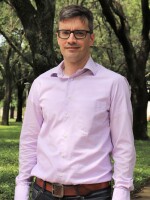St. Petersburg Mayor Ken Welch has picked the developer he wants to reimagine the Tropicana Field site.
The big reveal came at the end of the mayor’s State of the City address on the steps of City Hall on Monday, where Welch announced the Hines-Rays development team would be the city's "partner in progress" for reimagining the site.
Welch talked about visiting his grandfather’s wood yard in the Historic Gas Plant District as a child, and what was lost when it was razed and the baseball stadium was built there.
“It was a community," said Welch.
"It was evidence of the perseverance of the African American community that endeavored to turn a red line part of our city into a neighborhood of commerce, faith and family. And it represents a monumental unfulfilled promise that will finally be kept.”
Welch said fulfilling that promise means providing affordable housing, jobs, and meaningful inclusion of the African American community.
And he said the Hines-Rays proposal is the best of the four competing proposals to do so.
Reaction to the mayor's selection of the Hines-Rays team to develop the site has been mixed, but Welch says the community will be asked for input as the project takes shape.
Joining Florida Matters to discuss what the decision means for that neighborhood and the city of St. Petersburg — and what comes next — are WUSF’s Steve Newborn, who covers politics and the environment.
WUSF’s Gabriella Paul, who reports on living paycheck to paycheck
Tampa Bay Business Journal reporter Breanne Williams.
Rev. Jana Hall-Perkins, senior pastor at McCabe United Methodist Church in St. Petersburg.
And St. Petersburg resident William Graveley.
Newborn said Welch explained his rationale for the decision by saying the Hines-Rays team "had the means to make it happen. It's going to take over a decade at least for this all to happen, but they had all the financial backing and the knowledge to make this happen in the end."
Although the Hines-Rays proposal had the lowest proportion of affordable housing, Paul said housing experts she had spoken to noted that "nothing is set in stone."
"So as these formal negotiations start happening between the developer and the city, I think that the number of affordable housing units may change. And in fact the CEO of Dantes Partners, who is the lead with the Hines-Rays proposal, Buwa Binitie, said that number very may well grow. He's open to that."
Hall-Perkins said the McCabe United Methodist Church building that was constructed in 1919 off Ninth Street South is now a parking lot for Tropicana Field.
"So McCabe was once part of this community that is at the center of this conversation. It was once a gathering, not just of people of faith, not just United Methodist people, but the whole community.
Hall-Perkins said she was "a little bit disappointed" by the proportion of affordable housing in the proposal.
"I think there are many people in the community who just had hoped that whatever plan was selected, would do a little bit more for the residents who are still here, and still struggling in many ways and trying to recover a sense of community, recover a sense of being able to live and thrive in the same city that they grew up in and that they work in."
Graveley said the Gas Plant community was part of his childhood: his grandfather's dry cleaning business was there, and Graveley eventually took over that business and ran it himself for a few years.
He said the industry and housing that was promised when the Gas Plant district was razed never came.
"It's been a source of great disappointment for our community, and I'm hoping that in the future there will be some sort of reparation. I'm hoping this plan will bring some sort of relief to the people who were really displaced in that whole move.
Graveley supports Welch's decision.
"I think the overall plan and the inclusion of the community and the way they reached out to a broad section of the community to get involvement and plan to keep them involved the whole way, I'm really happy about it."
Williams said the redevelopment will be transformational for St. Petersburg's economy.
"When you look at St. Pete like a puzzle, there have been edges that have been filled out and portions that have been filled out, the puzzle pieces have been in place for years, and these 86 acres have been a literal hole in this puzzle. And so when we talk about what it's going to do to the economy, the whole picture is going to shift of what St. Pete is once those pieces are put in place."
She said the 1.4 million square feet of new office space will mean more jobs, new corporations coming to St. Petersburg and business expansion.
One big question looming over the development is the Tampa Bay Rays themselves. The team still hasn't ruled out a potential move to Tampa.
“We’re at the very beginning here, and there’s a lot that still needs to go right for us to get a shovel in the ground," Rays president Brian Auld told reporters Monday.



